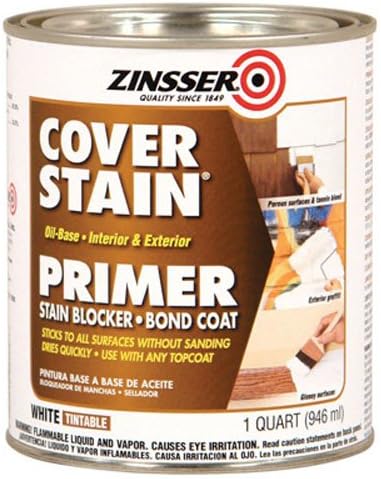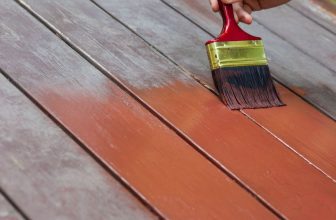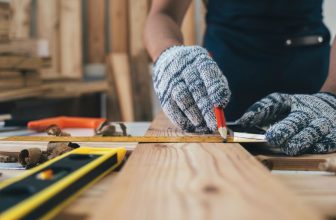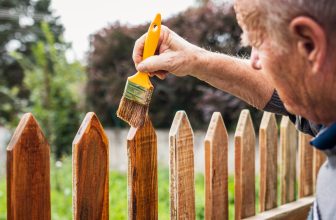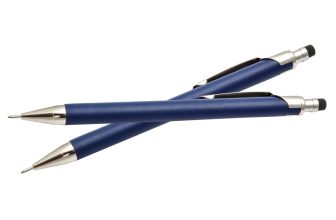Contents
Priming your wood projects before applying paint may seem unnecessary, but it results in a more professional-looking piece. After putting days or weeks into building something, it’s best to protect your hard work with a durable, professional-looking finish.
Not all primers are ideal for every project, and choosing the right one for yours isn’t always straightforward. I put together these reviews of my favorite wood primers and a buyer’s guide to help you find a product that suits your needs.
Best Wood Primers – Top Picks
BuildEazy.com may earn a commission if you purchase a product through one of our links.
Rust-Oleum is a well-known and highly trusted brand for primers, paints, and surface treatments. Their products are used across multiple industries.
This is a water-based primer that is thin and straightforward to apply. It goes on thick with a roller or brush, so you’ll likely only need one coat before you move to paint. It’s great for covering stains and blocking odors, so you can use this for restoring older projects as well as priming new ones.
You can apply this to just about any surface, including treated and raw wood, concrete, tile, plastic, and more. It’s ideal for projects with multiple mediums, and it’s unlikely to go to waste since it has many uses.
To see just how easily this adheres to normally unpaintable surfaces, check out this video:
This primer has a soft satin finish that is smooth when it dries. This means you won’t need to sand your surface after priming, making your finishing job significantly more manageable.
Applying a top coat over it is effortless. The primer remains flexible even after it is dry, so the wood can expand and contract freely without disrupting the coating.
It won’t chip, flake, or peel, which means you won’t have to re-coat regularly, and it’s unlikely to damage the paint you place over it.
It is mold and mildew resistant, so you can use it on areas that have been afflicted with spores or that will be exposed to moisture regularly and prone to mold growth.
It dries within an hour, so you’ll spend little time waiting around and can get to painting soon after you apply the primer.
It comes in a 1-quart can, which is relatively small but very affordable. Each can will cover about 100 square feet, so be prepared to purchase several if you have a large project.
KILZ L211101 Adhesion High-Bonding Interior Primer/Sealer
KILZ produces a number of painting and priming products, most of which are geared toward killing or covering mold. Professionals often use their sealers on moldy construction materials.
This primer is water-based, so it’s easy to apply quickly. It’s thicker than many similar formulas, making its application to porous or absorbent material like wood and concrete a breeze. I recommend using a dense, absorbent roller for the most straightforward application.
This product is mold-resistant and impermeable, so it’s ideal for sealing indoor and outdoor projects and protecting them from moisture and mildew. You can paint this over stained materials or those that have absorbed odors over time to renew the appearance and hide scents.
You can use this primer on just about any surface, and it’s ideal for wood, PVC, metal, and other slick materials that don’t often take paint well.
This goes on smoothly with proper application. If you’re new to priming, you may need to do some light sanding after it dries. However, I was pleased with the coverage and smoothness and didn’t need to sand before painting.
Paint sticks exceptionally well to this once it has cured. Priming with this product can reduce the time you spend painting and limit the number of coats you need, especially on absorbent materials like wood.
I found this primer to be very durable. It stands up to moisture well, and it doesn’t chip or peel even months after application.
It’s dry enough to re-coat in just an hour. I needed only one coat when I tested it, but you may find two coats will provide better results.
This comes in 1-gallon cans that are relatively cheap. Each gallon will treat about 300-400 square feet, so it’s suitable for larger projects.
Zinsser B-I-N Shellac-Base Primer
Zinsser is a line of painting and priming products made by Rust-Oleum and designed for professional use.
This is a shellac-based primer, making it exceptionally viscous. It goes on relatively thick, so you’ll likely only need a single coat. I recommend using a quality roller that can stand up to dense substances, as I found that cheaper options lost hairs that got stuck in the work surface.
This primer is one of the best options for covering stains and sealing odors on older pieces. It creates a very thick, impermeable membrane over your workpiece. It isn’t resistant to mold or mildew growth, so I don’t recommend it for exterior applications where moisture and water could be a problem.
It bonds exceptionally well to most surfaces, and it’s excellent for creating a protective layer over absorbent materials like wood and concrete. You likely won’t need much surface prep before applying it.
It dries smooth and will limit the amount of sanding you need to do after it dries. I was pleased with the results and didn’t end up sanding at all. The topcoat adhered very easily.
This primer is durable and won’t chip or flake. However, it won’t stand up to much precipitation and may begin peeling if your project is left outside.
Shellac-based primer often takes much longer than water-based options to dry. However, this one dries in just 45 minutes. You can prime and paint within an hour, which makes your job less time-consuming.
It comes in 1-gallon cans, and they are somewhat pricey. However, it has excellent coverage and will treat about 400 square feet.
KILZ Premium High-Hide Stain Blocking Primer/Sealer
This is a water-based primer that includes latex for a smooth, even coat. It requires minimal effort to spread this evenly, even on unsanded surfaces. I recommend using a roller that can hold a lot of material to make the application process as straightforward as possible. KILZ states that most projects only require a single coat, but I found that a second one led to the best results.
The seal it creates is robust and impermeable, so this primer is ideal for covering stains and blocking odors. It includes a mildewcide, making it an excellent option for both interior and exterior work. It will protect your surface from mold growth, moisture, and rot.
It adheres readily and quickly, so you can use this on most surfaces, including wood, metal, PVC, and concrete. It’s great for covering surfaces that would otherwise soak up a lot of paint.
It dries relatively smooth, so you may not need to sand between coats or before painting. I did a very light sanding to knock out any minor imperfections, but the finish would have looked professional even if I hadn’t. Paint sticks very well even to unsanded sections of this primer, so you’ll have no issues applying a topcoat.
This is durable and won’t chip or peel, even when exposed to the elements. This will help lengthen the life of your project and minimize the need to reapply primer and paint.
It dries in about an hour, so you’ll be able to apply two coats and at least your first coat of paint in a single afternoon.
It comes in 1-gallon cans and has a good shelf life, making it ideal for any size project. This is one of the cheapest primers available, so it provides excellent quality for the money.
Zinsser 03504 Cover Stain Primer/Sealer
This is an oil-based primer, which means it’s thicker than water-based options. It is effortless to use, and you’ll find that you can get ample coverage for single-coat applications without too much trouble. However, I strongly recommend using a high-quality roller, as cheaper ones won’t last through a gallon without falling apart or getting matted and becoming useless.
Oil-based primers are exceptional at covering stains and masking odors, and this one is no exception. It doesn’t have any mildewcide in it, so it won’t kill mold spores on your work surface. However, it creates a robust seal over wood and can help reduce damage from moisture and water. As such, it’s suitable for interior and exterior use.
It adheres well to just about any material, so you can use this on wood, cement, and PVC. The thickness means it won’t soak readily into porous surfaces, so you can also use this to prime medium-density fibreboard (MDF).
It levels beautifully once applied and leaves a smooth, shiny finish. You likely won’t need to sand afterward, and your topcoat will bond to it with ease.
It won’t chip, flake, or peel, even when exposed to rain and high moisture levels. You can trust that your project will be well-protected in most conditions.
Most oil-based primers take significantly longer than water-based ones to dry. However, this primer is ready to re-coat or paint over in just one hour, so you’ll get the superior coverage and performance of an oil-based formula without having to wait an extended period for it to dry.
This comes in 1-quart cans that are very expensive. It may be cost-prohibitive to use on larger projects.
Oil-based primers often have a high volatile organic compound (VOC) concentration. This product has relatively low VOC levels, but you should still wear a respirator and maintain adequate ventilation in your workspace.
INSL-X SXA1109A-04 Stix Acrylic Waterborne Bonding Primer
INSL-X manufactures a variety of primers and sealers with unique qualities, like water, fire, and rust protection.
This is a water-based primer with an acrylic-urethane additive that makes for exceptional bonding qualities. It’s easy to apply and provides good coverage with one to two coats. It’s relatively thick, so I recommend using a high-quality roller to avoid hairs coming loose and getting trapped in the surface.
The cured product has enamel in it, which does a decent job of covering stains and blocking odors. As such, you can use this to help restore older projects that have taken some abuse. It doesn’t have a mildewcide, so it’s not the best for outdoor wood projects that may get moldy in response to rain and moisture.
The acrylic additive makes it ideal for most mediums. It doesn’t soak much into even the most porous or absorbent material, so you can seal wood, concrete, MDF, and other surfaces to create a nice base for a topcoat.
It leaves a somewhat smooth surface, but I found that it needed sanding between coats for the best results. This will increase your working time a bit.
It seems durable, and paint sticks to it readily. Be careful not to touch the surface while it’s drying, as this will cause fairly severe peeling. It’s otherwise a hardy and protective coating.
It takes about four hours to dry, so you’ll likely only be able to apply one or two coats each day, mainly because you’ll need to sand after each layer.
This primer comes in 1-quart cans and is one of the most expensive products I tested. Each quart covers 75 to 100 square feet, so this may be far too costly if you have a large area to cover.
Diamond Brite Paint 31900 Oil Base Primer
Diamond Brite makes enamels, primers, and other protective coatings designed for professional use.
This is an oil-based primer that is one of the most viscous with which I’ve worked. I strongly recommend you invest in a good roller explicitly designed for latex or oil paints and primers. It goes on incredibly thick without much effort at all. Even beginners will likely only need a single coat to get adequate coverage.
It’s an excellent option for covering stains and odors. The barrier it creates over your wood surface is dense, so I’d be confident painting this over just about anything, including oil stains, rust, and mold spores. It has a mildewcide that will help defend against further mold growth, making it ideal for both indoor and outdoor use.
This contains an enamel, which is hard and durable once it cures. Unlike many other primers, this one will add some physical protection to your wood surface. It will help resist scratches, scuffs, and general wear, extending the life of your project.
It adheres to most surfaces with ease, and it’s great for highly porous materials. I’d recommend this for wood, MDF, concrete, metal, drywall, and just about anything else you want to prime. The bond it forms is very powerful, so it won’t flake, chip, or peel beneath your paint.
It takes topcoats easily, so you should only need one or two coats of paint once your project is primed. However, it takes 24 hours to cure, which means finishing a single project will likely require several days’ time.
It contains a higher concentration of VOCs than many other options. As such, the odor is relatively strong, and you should avoid inhaling the vapors. I strongly recommend a respirator while you use this product, and only apply in well-ventilated areas.
It comes in 1-quart, 1-gallon, and 5-gallon buckets, and you can expect an impressive 250-300 square feet of coverage per gallon. It’s affordable and provides good value for the price.
Buyer’s Guide
Choosing the wood primer that is best for your project comes down to a few key factors, including how thick and easy to apply the formula is, how protective it is against mold and moisture, and how readily it accepts paint once it’s dry. Consider the below when shopping to get the best product for your purposes.
Why Use A Primer Before Painting Wood?
Primer looks and often goes on just like paint, so many woodworkers and DIYers don’t understand the need for it. I’ve heard many fellow craftspeople say they’d rather save the money on primer and just apply an extra coat of paint. If you want a uniform, professional-looking finish on your wood surface, primer is a very important first step for three reasons.
Smooth Surface
The primary reason is that wood isn’t perfectly smooth. Even when you sand a surface extensively and get down to 320-grit sandpaper, the wood grains and fibers will still create unevenness. Paint adheres most readily and cures evenly on flat surfaces, so wood is generally a challenging medium to cover.
Whether it has an oil, water, or shellac base, wood primer creates a thick layer on top of those raised fibers and grain patterns, leaving the surface smooth and flat. Primer is designed to be too thick to soak into the wood like a stain or paint might. Once it cures, you’re left with a latex-like surface that paint will glide over smoothly.
To get a better idea of how this works, check out this video:
Not Absorbent
Wood is very absorbent, so most liquid applications will seep in between the grain. This may be desirable for something like a wood sealer or waterproofing polyurethane, but it can make applying paint frustrating.
The easiest surfaces to paint are those that absorb little or no paint. A wood primer seals your project so that paint will adhere to it rather than soaking beneath the surface.
A primed piece of wood is effortless to paint, while raw wood can take several coats and still not be fully covered or smooth.
Covers Color Variations
Wood primer is very dense and can cover any variation in color on your project. When you paint raw wood, even several coats of paint won’t always cover grain patterns or dark knots. These small differences in color from section to section can stand out and look unprofessional on a finished piece.
On older projects that have taken some abuse, stains from oil, pets, or spills in your shop can cause color variations. Instead of sanding these imperfections down and re-painting, primer can make quick work of them in addition to sealing any odors from whatever caused the stains.
The best primers cover even the darkest spots with just one pass, which means you can leave your project looking beautiful and even with fewer total coats.
To get an idea of how thoroughly a good primer can cover even the darkest colors, check out this video:
Types of Primers
There are three primer bases from which you’ll have to choose. Each interacts with wood differently and can help determine which product is right for you.
Water-Based Primers
Water-based primers are the thinnest of the three. They’re easy to mix and apply, but they often require two coats to get full coverage because they’re the least dense.
They dry the fastest and often have re-coat times of about an hour, and sometimes even faster. With a water base, you can usually begin priming and finish at least one coat of paint within an afternoon, making your job significantly faster and more manageable than with other bases.
They tend to have the lowest concentration of volatile organic compounds (VOCs) dissolved in them. I still recommend you wear a respirator and only use them in well-ventilated areas, but they’re generally the safest to apply.
Some woodworkers find that they are the least likely to require sanding between coats because they are so thin. I haven’t found this to be the case unilaterally.
Oil-Based Primers
Oil-based primers are significantly thicker than those with a water base. They are exceptionally straightforward to apply and require minimal effort to get a thick, even coat.
A downside of oil-based primers is that they typically take much longer to dry. Many require 24 hours before sanding or re-coating, which can make completing a project very challenging and time-consuming. However, this isn’t the case with all of them. For example, the Zinsser 03504 Cover Stain Primer/Sealer is ready for re-coating in about an hour, which is just as fast as water-based options.
They often have a high concentration of VOCs, making them less safe than many water-based formulas. They require that you wear protective gear – including a face mask – at all times, and they’re best suited for outdoor application.
Oil-based primers are better than water-based options for covering color variations and sealing odors.
Shellac-Based Primers
Shellac-based primers are typically even thicker than their oil-based counterparts. It’s effortless to get a dense coverage, and they generally only require one coat.
They usually have the highest VOCs concentration and require that you wear a face mask or respirator while you use them. You’ll also need to ensure you have plenty of ventilation in your workspace.
They generally take about as long as oil-based primers to cure, so you’ll likely have to wait an entire day before sanding or re-coating.
Shellac-based primers have the best coverage for stains, odors, and color variances, so they help reduce the total number of coats you’ll need to apply to your project.
Smell
Every wood primer I’ve used has had some kind of odor, varying from manageable to overwhelming. The smell is usually correlated to the concentration of VOCs in the formula, with a more pungent odor indicating more hazardous vapors.
Regardless of how strong it is, I recommend wearing a face mask or respirator and only applying your primer in well-ventilated areas. Using the product outdoors is best if you can manage it.
Additionally, the odor may take just an hour to dissipate or up to a day while the primer cures. If you’re looking for a fast turnaround between when you finish priming and when your project is safe and bearable to be around, a water-based option is likely best.
Stain Coverage
The color variation on wood surfaces is common on new and old projects alike. Dark grain patterns, knots, and stains will all shine through many wood coverings. The best primers have dense color and enough coverage to cover color differences on your wood surface entirely.
The primers that don’t provide ample cover will often need two coats, which will extend your working time.
Drying Time
Sanding and finishing a project is many woodworkers’ least favorite part of the hobby, so the faster it’s finished, the better. How quickly a primer dries can drastically affect your working time.
Most water-based primers dry rapidly and are ready for sanding or re-coating in about an hour. Some products with an oil or shellac base can dry just as quickly, but most take several hours and up to an entire day.
The longer it takes to dry, the more time you’ll spend waiting and the less convenient the job will be to fit into your schedule.
Type of Wood
The type of wood you plan to treat can help dictate which primer is best for you. Softer woods like pine and poplar are more absorbent, so a thicker formula that won’t soak in as readily will make your job most comfortable. Oil-based or shellac-based primers are often best for super-absorbent surfaces.
Hardwoods like maple, redwood, and oak have a tighter grain structure and will naturally be less likely to let a primer sink in. All primers are usually suitable for less absorbent surfaces.
Bare Wood or Treated
Treating bare wood with primer usually isn’t an issue, but some woodworkers choose to paint previously finished projects. Sanding wood that has been sealed with polyurethane, shellac, or other protective coatings can be very time-consuming or unrealistic. Painting over these slick surfaces usually isn’t possible, as paint won’t adhere to them well.
However, many wood primers will bond to just about any surface, which means you can apply them right over any varnish.
Here’s a quick video showing how well this works:
Interior and Exterior Surfaces
The best primer for your purposes will be designed to stand up to the stresses you intend to put on your project. For example, some primers add a waterproof layer over your wood, which will protect your work from rain and snow. These are ideal for exterior projects like lawn furniture and outdoor handrails.
Other primers have a mildewcide mixed into them, so they prevent mold growth. Mold and mildew are common on wood that is exposed to moisture. As such, you may want to choose a primer that resists mold growth if you’re priming a project that you plan to keep in a bathroom, kitchen, or another area with regular moisture build-up.
Condition of the Wood
Most primers will work just fine if the wood you plan to paint is brand new and freshly sanded. However, older projects that are in poor condition may require a primer with exceptional coverage capabilities.
For example, wood that has water or oil stains, discoloration from pets, or other imperfections are best sealed with a primer designed for good coverage. The Diamond Brite Paint 31900 Oil Base Primer is a good candidate for such jobs.
Projects that have seen a lot of use can also have odors trapped in them, including smells from cigarette smoke, pets, and household chemicals. Some primers that are made specifically to create an impermeable seal, like the Zinsser B-I-N Shellac-Base Primer, will cover odors most effectively.
If the Wood Has Already Been Primed or Painted
Projects that have been primed or painted already can often be treated with a primer with any of the three bases. Primers are made to bond to any surface readily, so painting them over existing primer or paint coats shouldn’t present any adhering issues.
However, covering bright or dark colors can be a challenge. If you’re looking to go from black or dark brown to a lighter color, a thick primer with a white color will be your best option for a one-coat solution. If you want to cover a vivid color with another color, most primer bases will do, and a white or grey formula would serve you just fine.
Frequently Asked Questions
What Happens If You Don’t Use A Wood Primer?
Regardless of whether you’ve got years of painting experience under your belt or you’re a recent homeowner that’s looking to try their hand at some DIY – then one of the most important things that you’ll need to make sure that you always remember to do is use a primer… and that goes for wood, too!
Wondering why that is? Well, even though you might be tempted to simply grab your can of paint and start transforming your wooden furniture a new color, if you don’t remember to use a primer prior to painting with your chosen color – you’re more than likely going to discover that your completed paint job is far from what you initially intended!
This is because a wood primer is able to effectively protect the surface that you are painting on (in this case, wood) while also helping to increase the bonding between the primer and the wood that you are painting.
Due to this, it should come as no surprise to hear that using a wood primer is an essential part of the painting process.
If you don’t use a wood primer prior to painting with your chosen color or varnish, then you’re most likely going to find that the paint begins to bubble, peel and lift, which will lead to you needing to remove it and restart the painting process all over again.
In addition to causing the paint to bubble and peel off, as you’re going to be painting on a wooden surface, there is also a risk of the grain of the wood rising due to being exposed to the moisture of the paint.
Not only could this cause the surfaces of your wooden furniture to become distorted, but it could also lead to a pretty hefty replacement cost, too!
Can I Gloss Wood Without A Primer?
Despite the fact that there are many people out there who believe that gloss holds similar properties to a primer (hence, meaning that there will be no need to apply a primer prior to applying gloss) it is widely recommended that you do make sure to apply a coat or two of primer before you go in with your selected gloss.
This is because the surface of all types of wood is extremely porous and filled with tiny little holes that we can’t detect with our naked eyes.
For this reason, if you were to simply go in with a gloss or a paint and begin applying it to bare wood, the gloss would seep deeper into the wood thanks to the little holes that form the surface of the wood – and this will more than likely lead to moisture problems, lifting, bubbling, peeling and more.
This is why it’s so important to make sure that you are always remembering to use a wood primer prior to using paint or gloss.
Sure, while it might certainly seem like a tedious first step at the time, making sure that you apply a primer will ensure that your completed paint job is professional, flawless, and not going to peel or break!
Unchanged: Sure, while it might certainly seem like a tedious first step at the time, making sure that you apply a primer will ensure that your completed paint job is professional, flawless, and not going to peel or break!
As one of the most popular multi-surface primers currently available on the market, this primer will be dry in just 35 minutes, while the fact that it is a water-based formula will mean that you won’t need to worry about going to the extra trouble of sanding down your wood surface before going in with your primer.
As one of the most popular multi-surface primers currently available on the market, this primer will be dry in just 35 minutes, while the fact that it is a water-based formula will mean that you won’t need to worry about going to the extra trouble of sanding down your wood surface before going in with your primer.
Not only that, but this awesome primer only needs one coat of primer instead of two, which will save you plenty of time, too!
Do I Need To Prime Treated Wood Before Painting?
If you are planning to wood furniture, then you might currently be wondering about whether or not painting pressure-treated wood is necessary.
Even though pressure-treated wood has the incredible ability to be able to enhance the wood’s natural ability to protect itself (including against both fungal and bacterial growth) it should also be noted that pressure treating wood does not mean that the wood is then going to be completely immune to decay or damage caused by a variety of external factors.
For this reason, if you are planning to paint your treated wood, we first recommend that you take the time to coat your pressure-treated wood with at least one to two coats of wood primer.
By doing this, you will help to ensure that you end up with a more professional finished paint job, while also helping to ensure that the wood does not become damaged from the moisture inside the paint – which can cause a whole host of problems, including bubbling, peeling and even distortion of the wood’s natural grain situated across both the surface and deeper layers of the wood.
Is There A Clear Primer For Wood?
Even though making sure to paint your wood surfaces with a wood primer can quite often seem like a tedious step, the good news is that doing so will not only help to make sure that your completed paint job lasts longer, but will also help to ensure that it has a professional finish too.
Alongside all of those benefits, the good news is that you also have the opportunity to be able to choose from a variety of different wood primers in accordance with your preferences – and that goes for clear-colored primers, too.
What Color Of Primer Should I Use?
When deciding what color primer to use, then the good news is that there really is no right or wrong answer.
Instead, the color of primer that you decide to use will ultimately depend on your personal preferences, as well as what type of color you want your wood furniture to be.
As a side note, even though the color of the wood primer isn’t going to impact the performance or quality of the wood primer, it is worth noting that darker colored primers might cause your completed, painted wood to be a little darker in color than you might have first intended.
For this reason, while you are deciding what wooden primer to use, we recommend that you consider what color you want the end result to be, and choose the prime color in accordance with that.
Conclusion: Which Wood Primer is Best?
Wood primer can make painting significantly more manageable, require fewer coats, and seal stains and odors in older projects. However, primers vary significantly in the drying time and convenience of application, and some are suitable only for indoor projects where moisture and water aren’t a threat.
Although no wood primer is perfect, my favorite one is the Rust-Oleum 2004 Zinsser Bulls Eye 1-2-3 Primer. It’s effortless to apply and can be placed over most surfaces, including those that have been previously finished. It will also help limit the time you spend working, as you won’t need to sand between coats.






